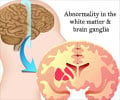Using a new analysis tool, scientists - for the first time - have revealed shape differences in the brains of kids Attention-Deficit Hyperactivity Disorder (ADHD), which could help
Using a new analysis tool, scientists - for the first time - have revealed shape differences in the brains of kids Attention-Deficit Hyperactivity Disorder (ADHD), which could help pinpoint the specific neural circuits involved in the disorder.
The new tool, called large deformation diffeomorphic mapping (LDDMM), allowed researchers at the Kennedy Krieger Institute in Baltimore, Md. and the Johns Hopkins Center for Imaging Science to examine the precise shape of the basal ganglia.In the study, the researchers found that boys with ADHD had significant shape differences and decreases in overall volume of the basal ganglia compared to their typically developing peers.
Girls with ADHD did not have volume or shape differences, suggesting sex strongly influences the disorder's expression.
LDDMM provides detailed analysis of the shape of specific brain regions, allowing for precise examination of brain structures well beyond what has been examined in previous MRI studies of ADHD.
In this study, LDDMM was used to map the brains of typically developing children in order to generate a basal ganglia template.
After creating LDDMM mappings of the basal ganglia of each child with ADHD, statistical analysis was conducted to compare them to the template.
Advertisement
Moving beyond the standard volume analysis, the LDDMM revealed shape abnormalities in several regions of the basal ganglia. Comparison of the standard volume and LDDMM analysis of girls with ADHD and their typically developing peers failed to reveal any significant volume or shape differences.
Advertisement
In fact, it seems that the disorder involves abnormalities in parallel circuits, including circuits important for the control of complex behaviour and more basic motor responses.
According to the researchers, findings revealing abnormalities in circuits important for basic motor response control may be crucial to understanding why children with ADHD have difficulty suppressing impulsive actions.
"Using LDDMM, we can more accurately measure the impact of ADHD on brain development, which will not only bring us closer to unlocking the biological basis of the disorder, but help us better diagnose and treat patients," said Dr. Stewart H. Mostofsky, senior study author and a pediatric neurologist in the Department of Developmental Cognitive Neurology at the Kennedy Krieger Institute.
The study is published in the online advance edition of The American Journal of Psychiatry.
Source-ANI
SK















